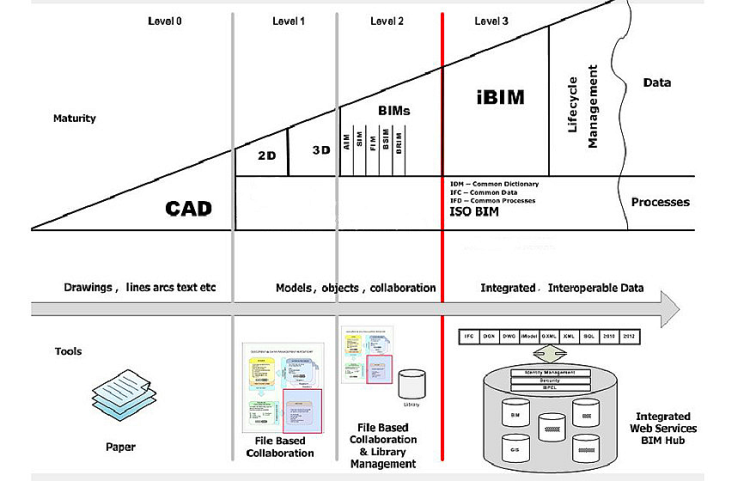What is BIM
BIM or Building Information Modeling, is a process involving the generation and management of digital representations of physical and functional characteristics of places. BIM is supported by various tools, technologies and contracts (Wikipedia)

BIM Level 0 – Low collaboration
This level of Building Information Modeling only includes 2D drawings using CAD (Computer Aided Design). Participants only share files, documents, drawings etc. via electronic prints and paper. There is no collaboration.
Most consultancies are currently operating at this level. 2D CAD systems that offer a simple representation of design and documentation. Very difficult and time consuming to use in even complicated small projects ($$). Co-ordination with builders and other consultants is often confusing and may leads to variations. Though, this has worked for 30 years, the expectations of our Clients are increasing beyond what it can offer.
BIM Level 1 – Partial collaboration
It is not only about 2D CAD here, but 3D BIM is also used. In level 1 BIM, teams are sharing information using a Common Data Environment (CDE). That allows them to collaborate easily on projects. Documentation is still largely done using 2D CAD.
This is the entry level for businesses. Here is where the crossover begins between 2D CAD & 3D BIM. You can ustilise the power of the 3D BIM environment to better understand and better design the projects that you are overseeing. The difficulties are easily seen and solutions are easily found. All 3D BIM models are separate, but a final ‘grouped’ model can be created for clash detection and construction co-ordination. E-struct can upgrade your systems to integrate the 3D BIM component, while allowing you to continue with final documentation in the 2D CAD area. This is the best way to begin your journey into 3D BIM.
BIM Level 2 – Full collaboration
All participants are using their own 3D BIM models, but not necessarily working on a single, shared model. Collaboration occurs between different disciplines, by using a common file format i.e., IFC (Industry Foundation Class). IFC allows project’s actors to access the data so everyone is able to work on the model.
This is what is sometimes considered ‘true’ 3D BIM. Here is where the dynamic capabilities of 3D BIM can be harnessed. All consultants are operating with full 3D BIM Models, but not necessarily the same one. All documentation is produced from the 3D BIM Model. As every project can have changes and variations to what is designed, making a change to the model, changes all the plans and details effected by that change. From a single bolt, to reinforcement details are instantly changed to the new requirement (notation and all). This is the standard aspired to overseas (US, UK & Europe) and is utilised by most Tier 1 consultants in Australia. E-struct can bring you to this level.
BIM Level 3 – Full Integration
The level 3 of BIM is about full collaboration, that means every discipline collaborates through the same shared project. It includes 4D (construction sequencing), 5D (cost), and 6D (project lifecycle information). Everyone can access the data, and edit it. This is what we call Open BIM.
Incorporates all aspects of 3D BIM, but brings it to the next level. From the Engineers (Civil, Structural, Hydraulic, Mechanical & Electrical), Architects (Building, Landscaping), Project Managers & Builders are integrated together using a single Cloud based Collaboration BIM model. Every change is shown on the Collaboration BIM Model. Clash detection is continuous. The model can becomes the source of the project specifications. This is used by the Level Crossing removal projects where the model directly was used for reinforcement fabrication and formwork production. It even showed the rails and the overhead wires. E-struct can assist with this by helping you integrate your projects into the cloud Collaboration BIM models. We can assist Project Managers and Builders to utilise Collaboration BIM management to elevate their capabilities.
BIM Levels

Essentially BIM is digital prototyping. Being able to create every aspect of your project in virtual space. In the case of buildings, the structural elements (e.g beams). In the case of a car, the engine & body components. It is applied widely and used virtually everywhere.
BIM goes beyond just the model. The use for project management and costing is all part of what it is. The components are virtual, but they have real-life information defining them. Size, weight & materials can be gleened and used to determine quantities and most importantly costs.
© Copyright E-struct Pty Ltd 2024